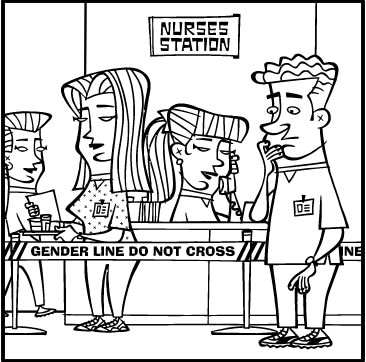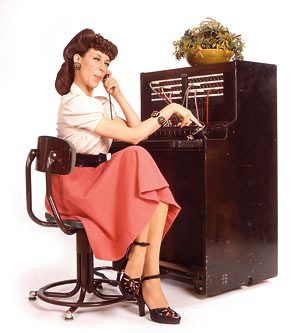Gender and Technology: A Power Struggle
We have established throughout our discussions that the relationship between gender and technology is bi-directional. The two are inextricably linked and each one takes some role in constructing the other. Technology can gender us, but we can also be gendered by technology. A simple example of this would be the technology of make-up and cosmetics, which genders its users as feminine (for the most part). On the flip side, technologies of beauty are traditionally gendered by society as feminine. Clearly, technology can gender humans, and humans have no problems gendering technology. If this is the case however, why does society have such difficulty breaking out of gender roles, stereotypes or practices that technology itself has defined? Let us take the example of the nursing profession. As we learnt in one of our panels, the nursing profession started out as a male-oriented career and nurses both use and represent various technologies that were once associated with masculinity or maleness. The occupation is now heavily dominated by women, providing evidence of social re-gendering of the profession. This is not the case of telephone operators however, whose profession started out as a liberating career for women (i.e. a technology that was gendered by society) but has turned into what one person on the panel describes as a “female occupational ghetto”, clear evidence that the technology of the telephone operators worked against them in repositioning what was already gendered into an inescapably gendered profession. It would appear from these examples that it is easier to regender technologies that we ourselves have already gendered, than to attempt to break free from gendered roles that technology has assigned a gender. There appears to be tension between the constant regendering of technology and the continual repositioning of gender by technology within itself.
The nursing profession, long seen as a women’s career, is a very good example of the ease with which society is able to regender technologies of profession. Currently, 6% of all nurse practitioners are men. The overwhelming female majority in this profession is the result society’s attempts to regender this job as being one that was originally intended for males, into one solely for females. While the feminization of the profession is a result of various axes of gendering, one of the biggest factors involved is the subtle (and sometimes not so subtle) exclusion of the male gender. What’s in a name? In this case, everything. The verb ‘to nurse’ literally means to breastfeed, a highly particular action, that only women can perform. The shunning of males from the profession does not stop there: Male nurses are subject to all sorts of assumptions, about their masculinity, sexuality and intelligence, from the women they work with, their patients, and society as a whole (see Fig. 1).
“There’s still a male nurse stereotype as some flouncy person dancing down the hallway of a hospital who is a woman wannabe,” said Robert Abel, a nurse manager at St. Luke’s Roosevelt Hospital in New York City. (Craig LeMoult, April 18 2006)
The presentation of gender in the profession is even evident in work attire (see Fig 2). In addition to these stereotypes of male nurses, the nursing profession is often presented as a gender, as Lisette Hilton explores in NurseWeek:
“We encounter a lot of hostility from female nurses. Because nursing as a profession is confused about whether it’s a profession or it’s a gender. Every other profession has changed except nursing. If you look at what nursing presents itself as, it presents itself as a gender. We’re women. In fact, we’re Caucasian women.” (Hilton, May 14, 2001)
While it is quite obvious that society is responsible for gendering the nursing profession and its various technologies, it is not as self-evident in the case of telephone operators. According to Hannah, the telephone operating profession became a women’s profession because we (i.e. society), decided that women were the best equipped for the job. Hence, telephone operating began as a technology that was gendered (as in the case of the nursing profession) by us. Women were hired because of their “dispositions”: sociable, calm, quiet and polite; they were perfect for verbally handling unruly customers. Similarly to women factory workers of the Second World War, women were recruited into telephone operating through a sense of patriotism (Fig. 3). Unlike the many Rosie the Riveters
that were then forced to return back to their homes after their husbands came back from war, women telephone operators were allowed to keep their jobs, and the profession soon became seen as a liberating step for women who wanted to get out of the house. However, it soon became evident that the reasons for keeping women in the profession were that employers could get away with paying them less. The profession became hyper-feminized (See Fig. 4: Comedienne Lily Tomlin portraying the character “Ernestine the Telephone Operator on her TV show) and women became stuck in this “occupational ghetto” that offered no options other than to stay trapped within the profession. In this case, it is clear that technology (technologies of economy and inequality in particular) was able to reposition gender within the profession.
From these few examples we can see the constant struggle to regender technology and to reposition gender that is represented by the relationship of gender and technology. Regendering and Repositioning appear to exist on some kind of spectrum or continuum, with each one on either end. This raises larger questions of where the line between the regendering of technology and the repositioning of gender exists. Or if it exists at all.
When and where do we start gendering technology? And when does technology start to gender us? I would be interested in exploring these ideas further, particularly in professions that are traditionally gendered as male (for example: truckers) that women find difficult to position themselves in.
Works Cited:
Hilton, Lisette. “A few good men”. http://www.nurseweek.com/news/features/01-05/men.html
LeMoult, Craig. “Why so few male nurses?”. http://jscms.jrn.columbia.edu/cns/2006-04-18/lemoult-malenurses
Images:
Fig. 1: http://carlislehistory.dickinson.edu/wp-content/uploads/mz-male_nurse.jpg
Fig.2: http://www.secondglanceuniforms.com/images/scrubs2.jpg
Fig. 3: can’t find the link anymore!
Fig. 4: http://blogs.dallasobserver.com/unfairpark/Lily_Tomlin_telephone_operator.jpg
Comments are closed.




Nat–
Like your last paper, this one works the divide between individual and society, a binary you reconstruct here as gender and technology, each “taking some role in constructing the other.” Last month, I questioned the binary construction itself, asking “how much of what we call ‘individual’ is actually socially constructed,” and “how much of social construction is an amalgam of individual choices?” I find myself wanting to ask exactly the same (sort of) questions again this time ‘round. You look @ some of the historical specifics of regendering (nursing) and repositioning (telephone operating), wondering “where the line is” between the two, or “if it exists @ all.” What puzzles me is that—having started w/ a sharp description of the bi-directionality of the process—you are looking for the line @ all. Clearly, in the backing-and-forthing that is culture’s scripting of the individual and individuals’ re-writing of culture, the dance of regendering and repositioning will tilt first one way, then another.
Along these lines, you might want to look @ the essays that Natasha
and Rebecca wrote on related dynamics. Both of them end w/ hopeful gestures toward the possibilities of change that such a process ensures. You seem much less hopeful than they are (I think?), both beginning and ending with questions about “why society has such difficulty breaking out of gender stereotypes.”